Today we are going to discuss how to make money writing.
Here’s what we will cover:
- Freelance writing.
- Blogging.
- Self-publishing.
Want to become a full-time writer in 2024?
Continue reading…
Freelance Writing
Freelance writing is the most straightforward way to make money writing online because you can start generating income immediately.
Here’s how you can build a successful freelance writing business…
Pick a Niche
You want to pick a writing niche from the get-go.
Ideally, it should be something that you are already knowledgeable about or at least interested in.
Also, instead of going with a broad niche, consider narrowing down your scope to a specific sub-niche within it.
Say, instead of specializing in online marketing, you could niche down to ecommerce, email marketing, SaaS, etc.
Build Your Portfolio
You can build your portfolio by writing free articles for popular websites in exchange for a byline. Which popular blogs in your writing niche accept guest posts?
Also, if you are struggling to land guest posts, then nothing is preventing you from starting your own blog on a platform like Typeshare amd Medium (once you publish some stories, you can apply to join Medium Partner Program). No excuses!
Make sure to have 5-10 high-quality pieces in your portfolio before you start reaching out to potential clients.
Set Your Rates
How much should you charge?
Typically, freelance writers charge by word, with the rates varying wildly – from $0.01 per word to $1+ per word.
We recommend you to start at a $0.05/word rate, then gradually increase it as you progress in your writing career.
It’s best to avoid organizations and individuals that pay freelance writers less than that – they tend to be what is known as “clients from hell”.
Get Clients
Where can you find freelance writing gigs?
Here are the three most popular options:
UpWork

UpWork is the most popular freelance marketplace in the world. Source: UpWork.
UpWork is the most obvious choice for freelance writers who are just starting but it’s not necessarily the best one.
The upside is that it offers an endless stream of writing jobs, the downside is that those gigs are typically bottom-of-the-barrel jobs that pay peanuts.
Moreover, the competition for these jobs is insane, with job ads often receiving dozens and dozens of applications.
That being said, there are some freelance writers who have found success on this platform, such as Danny Margulies who has earned hundreds of thousands of dollars freelancing there.
So it is possible to make decent money on UpWork. Just keep in mind that the deck is stacked against you.
ProBlogger Job Board
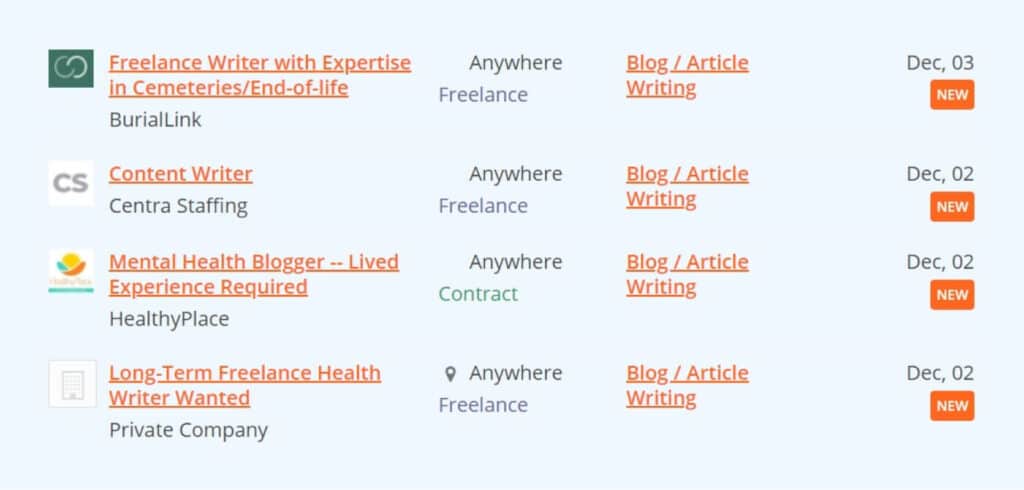
ProBlogger job board is the most popular job board for freelance writers. Source: ProBlogger.
A better option is to apply to jobs posted on the ProBlogger job board.
This is a place where serious content marketing agencies go to look for long-term freelance writers, so you are more likely to find decent freelance writing gigs there than on UpWork.
Of course, there’s a ton of competition there as well, but the clients typically aren’t looking for the cheapest writer, they are looking for the best writer that they can afford.
This means that having a solid portfolio will go a long way in helping you stand out from the droves of other writers applying for the same job.
Content Writing Jobs (That’s Us!)
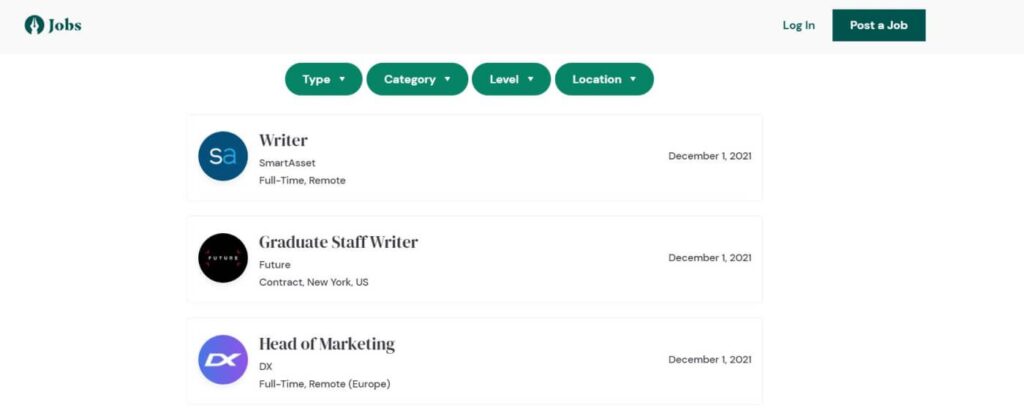
Content Writing Jobs is one of the best freelance writing job boards out there.
Content Writing Jobs is an upscale job board. We charge companies $100 to post a job.
This means that when you see a job ad, you can be sure that the company behind it is serious since they are willing to invest money into finding a great freelance writer.
Also, you can sign up for our daily newsletter and get new jobs straight into your inbox, which can help you be the first to apply. Speed matters!
Cold Outreach
Arguably, cold outreach is the most effective way to get a high-paying freelance writing job, but it also takes the most initiative.
Here’s how you can start your cold outreach campaign:
- Make a list of your top 100 potential clients.
- Identify the decision-maker in each company.
- Find the contact details for each decision-maker (Hunter is a great tool for finding email addresses).
- Start reaching out to decision-makers via cold email and cold LinkedIn messages.
- Make sure to keep following up until you get a yes or no answer. Don’t expect busy people to reply to your first email.
You should be able to land at least a few freelance writing gigs this way.
However, if you have reached out to a hundred potential clients, but none of them were willing to hire you, you might want to take a step back and analyze your approach:
- Should you pursue different clients?
- Get better writing samples?
- Write better cold emails?
Figure out what the issue is and fix it. Then go back to cold outreach with a new list of 100 potential clients.
Raise Your Rates
Once your freelance writing business starts gaining momentum, it’s time to begin gradually raising your freelance writing rates.
The best way to do this is to keep your current clients at the old rate, but also start looking for new clients that are willing to pay more.
When you are confident that you can land writing jobs at your new rate, you can start raising your rates with your existing clients.
Typically, if their budget allows it, they will probably agree to increase your rate because they will not want to deal with the hassle of replacing you.
Of course, you should also be prepared in case they say no, whether that would mean continuing to work with them at the old rate or ending the partnership so that you could take on higher-paying clients.
Also, just to give you an example of what’s possible, freelance writer Kaleigh Moore who specializes in ecommerce and SaaS content has worked her way up to $1.25 per word for one-time assignments such as blog posts.
If you have followed our advice and started out charging $0.05 per word for your writing services, increasing that to $1.25 per word would mean going from $50 per 1,000-word article to $1,250 for a 1,000-word article.
So you can make a great living as a freelance writer if you play your cards right!

Kaleigh Moore charges $1.25/word for one-time assignments such as blog posts. Source: Kaleigh Moore.
Blogging
Blogging is another great way to make money writing online.
However, unlike freelance writing, where you get paid to write immediately, blogging requires an investment of at least 12 months of work until you can expect to see the results.
Pick a Niche
You should start by picking a niche for your blog.
We recommend going with one of these three niches:
- Health and fitness. Losing weight, gaining muscle, feeling better, learning specific skills, etc.
- Wealth. Building a business, making money online, getting freelance clients, etc.
- Relationships. Making friends, getting dates, finding love, building a professional network, etc.
Of course, you shouldn’t just pick a broad niche like “health and fitness”, you need to niche down further.
For example:
Health and fitness -> weight loss -> ketogenic diet -> carnivore diet.
Usually, new bloggers make the mistake of picking a niche that is too broad, so you might want to err in the opposite direction.
Use Search Engine Optimization (SEO) to Grow Your Blog
Your #1 priority should be growing your organic search traffic.
That’s where search engine optimization comes in.
Here’s SEO in a nutshell:
- Identify a promising keyword. There are plenty of free tools out there but we recommend you to invest in Ahrefs. You can learn the basics of keyword research in 10 minutes with this free tutorial.
- Create SEO content around it. SEO content is content designed to rank on the first page of Google search results for a specific keyword.
- Build backlinks to that content. A backlink is a link from someone else’s website to your website. You need to build as many backlinks to your content as possible if you want it to stand a chance of reaching the first page of search results. You can learn more about link building in this free tutorial.
You should repeat this process for every article that you publish on your blog.
Build an Email List
You should also focus on building your email list.
Here’s how:

Jon Morrow, a popular blogger and writing coach, uses this cheat sheet as one of his lead magnets. Source: Smart Blogger.
- Create a lead magnet. A lead magnet is a freebie that you offer to your readers in exchange for their email addresses. It can be an ebook, an email course, a webinar, etc. What’s important is that it provides a solution to a problem that your readers are struggling with.
- Create a welcome sequence. A welcome sequence is an automated sequence of email messages that is sent to every new subscriber. You can set one up with any email marketing app (e.g. MailChimp, ConvertKit, etc.).
- Promote your lead magnet on your website. Add an opt-in box to your homepage (this is called a “feature box”), add an opt-in box at the end of each blog post, and display an exit-intent pop-up.
The more organic search traffic you generate, the more people will sign up for your email list, and the faster your email list will grow.
Monetize Your Blog
Once you have built an email list of at least 1,000 subscribers, you can start monetizing your blog.
Here are the three most popular ways to do it:
- Services. Selling your services is the quickest way to start making money from your blog. Say, if you have a health and fitness blog, then you might want to consider offering online coaching at a fixed hourly rate.
- Affiliate marketing. Affiliate marketing means promoting someone else’s product in exchange for a commission from each sale. This is the most straightforward way to start generating “passive” income.
- Info products. An info product is an educational product that can be either downloaded or accessed online such as an ebook or a video course. Selling your own info products is a more lucrative way to generate “passive” income than affiliate marketing.
Self-Publishing
You can also make money writing by self-publishing books.
Self-Publishing Overview
Let’s start by taking a look at the current self-publishing landscape.
Self-Publishing vs. Traditional Publishing
Why self-publish at all?
Both self-publishing and traditional publishing have advantages and disadvantages:
- Traditional publishing means having to go through gatekeepers, accepting lower royalties, and being bound by a contract.
Also, aspiring authors tend to be under the impression that traditional publishers take care of the marketing, but that’s simply not the case anymore. Be prepared to promote your book all by yourself even if you go the traditional publishing route.
However, when you publish your book this way, you get a guaranteed advance payment that you then have to earn out to start receiving royalties.
Say, you might get an advance payment of $5,000, then once your book royalties surpass that number, you start receiving royalty payments. This has “a bird in hand is worth two in the bush” benefit because self-publishing offers no such guaranteed income.
- Self-publishing means that you are free to publish whatever you want, you get higher royalties, and you remain unbound by contracts aka your own boss who makes all the decisions.
However, if you choose to go this route, you have to be prepared to handle everything yourself, from editing to cover art to marketing to sales and distribution.
Overall, we believe that self publishing is a better option for talented writers who have solid writing skills, provided that you are willing to put in the work to promote your book.
Amazon Self-Publishing vs. Independent Self-Publishing
Okay, so when it comes to self-publishing, there are two main options:
- Amazon self-publishing. You can self-publish your book via Amazon’s KDP (Kindle Direct Publishing) platform in Kindle, paperback, and hardcover formats. You can learn more about the royalty structure on KDP’s Royalties page. Self-publishing this way gives you access to Amazon’s vast customer base and its recommendation algorithm. It also doesn’t require an upfront investment because the paperbacks and hardbacks are only printed when someone buys a copy.
- Independent self-publishing. You can also self-publish your book independently as an ebook, a paperback, a hardcover, or all three. This might make sense if you have marketing chops and want to build your own sales funnel. The main benefit here is that you can set your own price for your ebook without it being anchored to Amazon’s prices (e.g. you can sell it for $37). Note that selling physical copies of your book might require an upfront investment – you might have to print the copies in advance.
We recommend going with Amazon unless you want to sell your book as an info product as opposed to a regular book.
Fiction vs. Non-Fiction
Self-publishing can work well for both fiction and non-fiction.
However, note that if you want to make a living self-publishing fiction, you need to be able to churn out 2-3 books per year. We are talking about full-length novels in the 50k – 120k word range.
Self-Publishing Non-Fiction
So how can you self-publish a non-fiction book on Amazon?
Come Up With an Idea
You need to find a painful problem that you can offer an effective solution to in a book format.
We recommend you to stick to the three previously mentioned niches: health and fitness, wealth, and relationships.
Validate Your Idea
Once you have an idea for your book, you should validate that idea before you write the whole thing.
Here’s how you can do it:
- Write the first chapter of your book.
- Set up a landing page where you use that first chapter as your lead magnet.
- Use Facebook Ads to drive traffic to that landing page and see what happens.
Are people downloading the free chapter?
This will give you an indication of whether there’s demand for the book that you have in mind.
Of course, if you have never used Facebook ads before, you will need to learn how to run them, which can take a while.
However, it’s better to spend time testing your book idea, than to waste it writing a book that is doomed to fail because no one wants it.
Outline Your Book
Validated your book idea?
Don’t jump straight into writing, make sure to outline the book first.
This will help you avoid various structural problems down the road. You don’t want to have to cut thousands upon thousands of words just because you didn’t think things through.
Write Your Book
Once you have your outline ready, it’s time to start writing your book.
The most reliable method for finishing a manuscript is to commit to writing a set number of words every day no matter what.
For example: If you write 1,000 words a day, you will produce 30,000 words per month, which means that you will have a 50,000-word draft in less than two months.
Edit Your Book
Once you have your first draft ready, it’s time to whip it into shape through the process of editing.
It is helpful to print out your manuscript so that you could go through the entire thing with a red pen, mark the places that need changes, and then make the edits on a computer.
You might also want to consider getting feedback at this stage. Do any of your friends or relatives belong to your target audience? You might want to show the book to them and ask them what they think.
Prepare Your Book Description
A book description is where you sell your book to the reader.
On Amazon, it can be up to 4,000 characters, but you should get to the point immediately because no one is going to read a description that long.
Here’s the question that you need to answer:
How will your book make the reader’s life better?
Note that studying copywriting principles can help you write better book descriptions.
Create Your Book Cover
You can hire a designer to create a cover for you on UpWork or Fiverr.
Make sure that your cover looks similar to the covers of the bestselling books in the same category – that helps readers to immediately understand what it’s about when they are browsing Amazon.
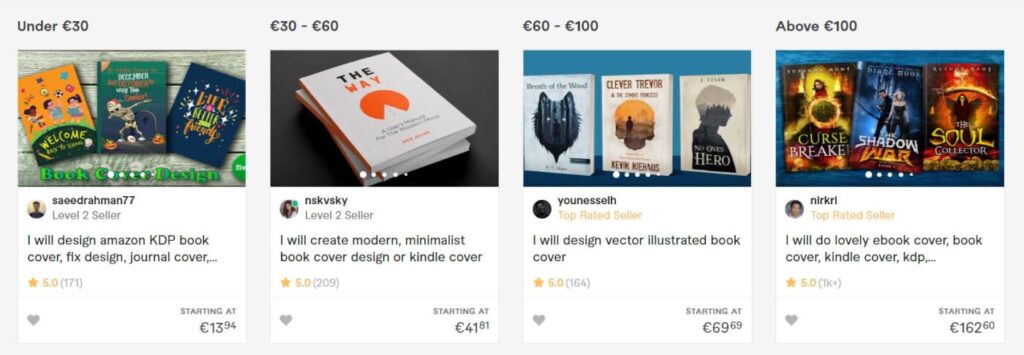
You can get a book cover on Fiverr. Source: Fiverr.
Publish Your Book
Simply follow KDP guidelines to publish your book.
Get Reviews
It’s important to get positive reviews before you start promoting your book because people are going to make snap judgments based on its rating.
Send copies of your book to family, friends, and anyone else who is willing to read it and leave a review on Amazon.
Just note that these reviews have to be realistic – if you have a 5.0 rating with 100 reviews, potential readers will be suspicious of it because it’s too good to be true.
Promote Your Book
Publishing your book is just the first step.
You then need to be proactive about promoting it:
- Send review copies to bloggers, podcasters, YouTubers, etc.
- Appear on popular podcasts in your niche and adjacent niches.
- Run Amazon ads.
Just to give you an example of what qualifies as proactively promoting your book:
When Dorie Clark released “Stand Out” in 2015, she secured 160 podcast appearances that year.
And with her next book, “Entrepreneurial You”, she secured the same number of podcast appearances in just four months. Now that’s proactive!
Also, you might want to read Robert Fitzpatrick’s Write Useful Books, which is about writing non-fiction books that grow in popularity via word-of-mouth without you having to stay on the marketing treadmill forever.
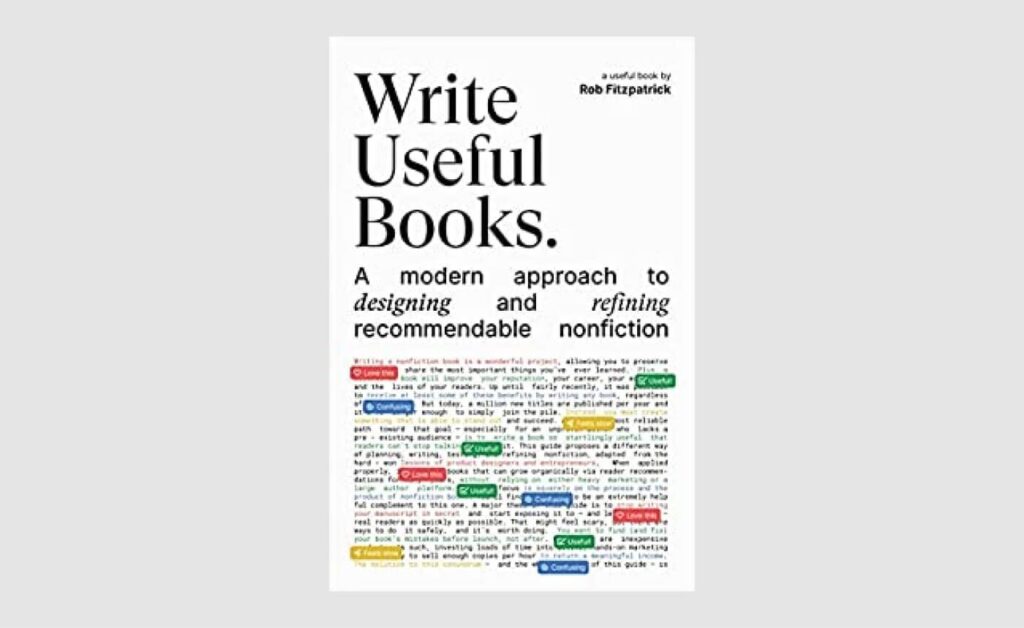
Write Useful Books by Rob Fitzpatrick can help you write better non-fiction.
Self-Publishing Fiction
Want to make a living writing fiction?
Here’s how you can get started…
Pick a Genre
You should start by picking a fiction genre.
Here are the five most popular ones:
- Thrillers.
- Romance.
- Young adult (YA).
- Science fiction.
- Fantasy.
As you can see, these are all entertainment genres, aka popular literature as opposed to high literature.
There’s no good money in writing literary fiction, so if your ambition is to become the next Dostoyevski, you might want to postpone that until after you have made bank with your vampire romance novels.
By the way, you don’t have to write under your real name, you can use a pen name instead.
Research Your Genre
Ideally, you want to choose a genre that you enjoy yourself, although it is possible to find success writing something that you normally wouldn’t read.
Either way, you should do your homework before you start outlining your novel:
- Go to Amazon’s Top 100 bestseller list for that genre.
- Read through the top 25 books. This takes time but it will help you understand the landscape. You should also read the classics of that genre even if they aren’t on the list.
- Take notes. What do these books have in common? Pay attention to the structure, plot, pacing, characterization, etc. Also, make sure to read the reviews on both Amazon and Goodreads. What comes up again and again?
You also want to search for what’s known as “beats” for your genre – for example, Gwen Hayes’ Romancing the Beat: Story Structure for Romance Novels provides beats for romance.
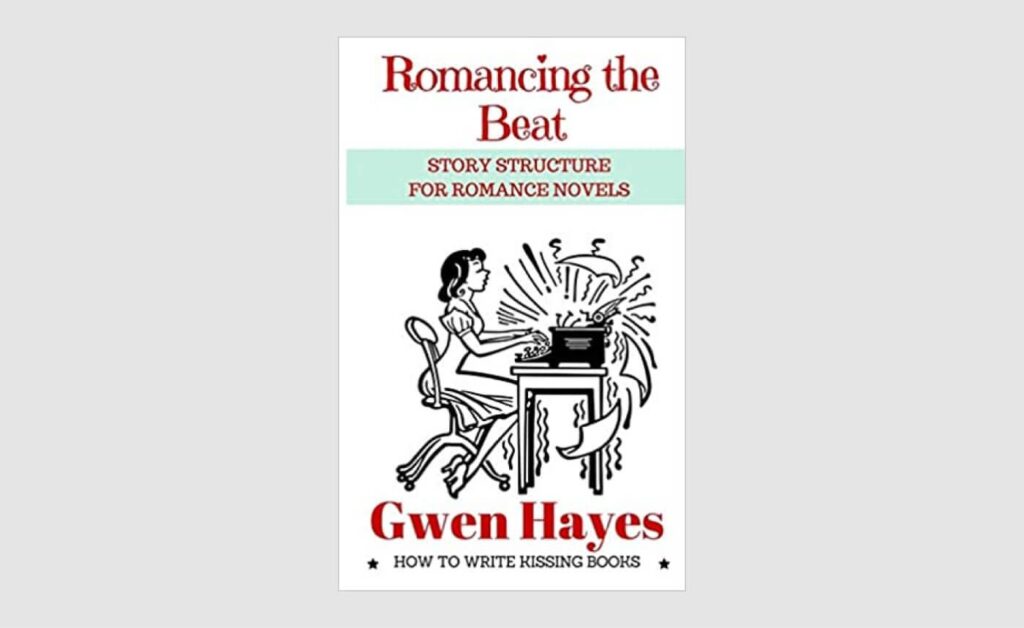
You should study the story structure that works for your genre. Source: Amazon.
Note that the aim here is to meet the readers’ expectations, not to go on a creative writing journey where you break all the rules. You need to follow the rules if you want to make money!
Outline Your Book
You should create a detailed outline for your novel before you start writing – use a beat sheet to create the structure, then break it down into chapters, then into sections.
Write Your Book
Just like with non-fiction, the most effective way to get the first draft done is to set a daily quota of words, say, 1,000 words per day.
You might want to check out Thomas Emson’s “How To Write A Novel In 6 Months: A published author’s guide to writing a 50,000-word book in 24 weeks” for a step-by-step plan that you can follow even if you have a full time job.
Edit Your Book
Once you have your manuscript, it’s time to edit it. Tighten the plot, sort out the pacing, remove fluff, catch errors, etc.
Renni Browne and Dave King’s “Self-Editing for Fiction Writer, Second Edition: How to Edit Yourself Into Print” might be helpful here.
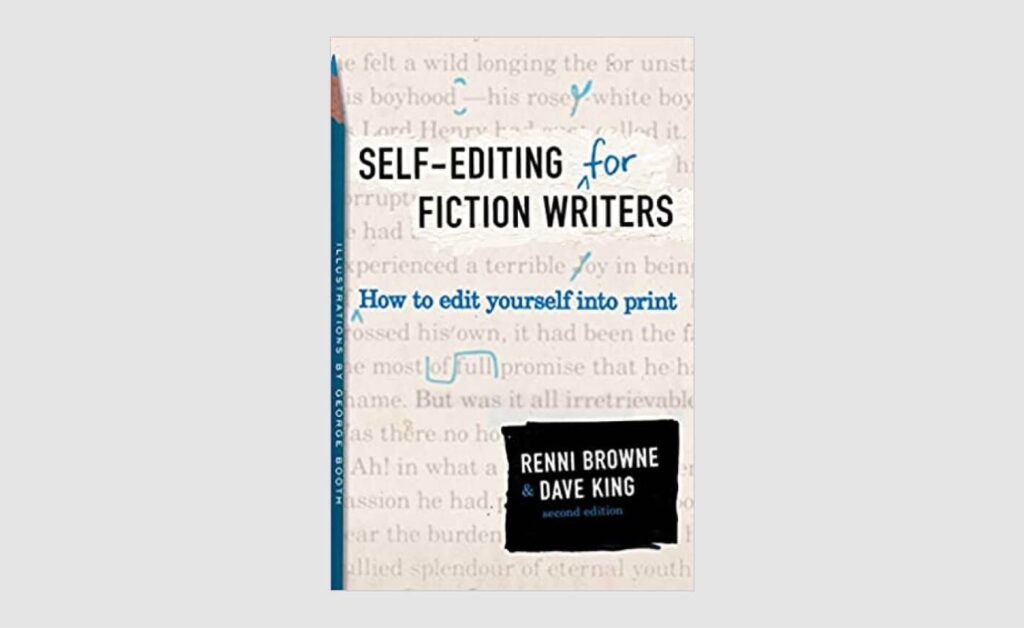
Self-editing your novel isn’t easy, but it can be done. Source: Amazon.
Prepare a Book Description
As we have already discussed, your book description is where you sell your book.
However, the difference between non-fiction and fiction book descriptions is that the former should focus on how the book will make the reader’s life better while the latter should intrigue the reader so that they would feel compelled to get the book.
The best way to learn how to write great book descriptions for novels is to study the descriptions of the bestselling books in your genre.
Create a Book Cover
You can hire someone on UpWork or Fiverr to create a cover for you.
Note that with fiction covers it’s even more important that your cover follows genre conventions – it should be immediately obvious whether your book is a domestic thriller or a paranormal romance or YA dystopia.
Publish Your Book
Simply follow the KDP guidelines.
Make sure that you set your price within the regular price range for your genre. Also, you can experiment with lower price points, say, $2.99 can work well for genre fiction.
Get Reviews
Just like with non-fiction books, reviews are of paramount importance, so make sure to offer people who love your genre review copies.
Promote Your Book With Ads
The most effective way to promote your novel is to run Amazon ads, so learn how to do it profitably.
Write More Books!
The best thing you can do to advance your writing career as a fiction author is to write another book. And then another one. And another one. Why?
Because the money is in your back catalog:
When you have one book out, someone who loves it can’t buy anything else from you.
But when you have 15 books out, they can start going through your back catalog. Some people might even buy everything that you have ever published under that pen name!
And once again, if you want to make a living writing fiction, you need to learn how to write novels fast – you should be putting out 2-3 books a year. How else are you going to build that back catalog?
FAQ
How can I earn money by writing?
Here are three ways to make money writing:
- Freelance writing.
- Blogging.
- Self-publishing.
How can a beginner make money writing?
Becoming a freelance writer is the most straightforward way to make money writing – you can get paid to write articles.
How to make money as a freelance writer?
Here’s how you can start making money as a freelance writer:
- Pick a writing niche.
- Build a writing portfolio by guest posting on popular blogs in that niche.
- Start looking for clients on freelance marketplaces and online job boards. You can also pitch your writing services to potential clients via cold email.
How to make money writing non-fiction books?
- Come up with a book idea.
- Validate your idea.
- Write your book.
- Publish your book.
- Promote your book.
How to make money writing fiction books?
- Pick a genre.
- Research your genre.
- Write your novel.
- Publish your novel.
- Promote your novel with Amazon ads.
- Write more books!
